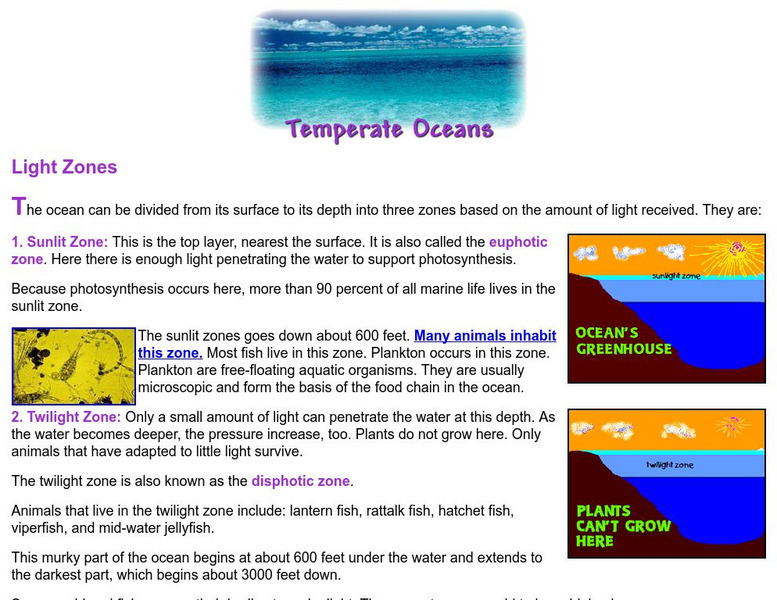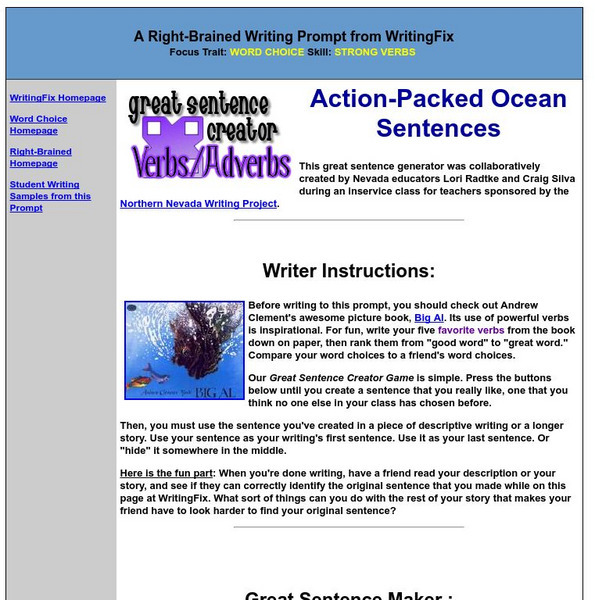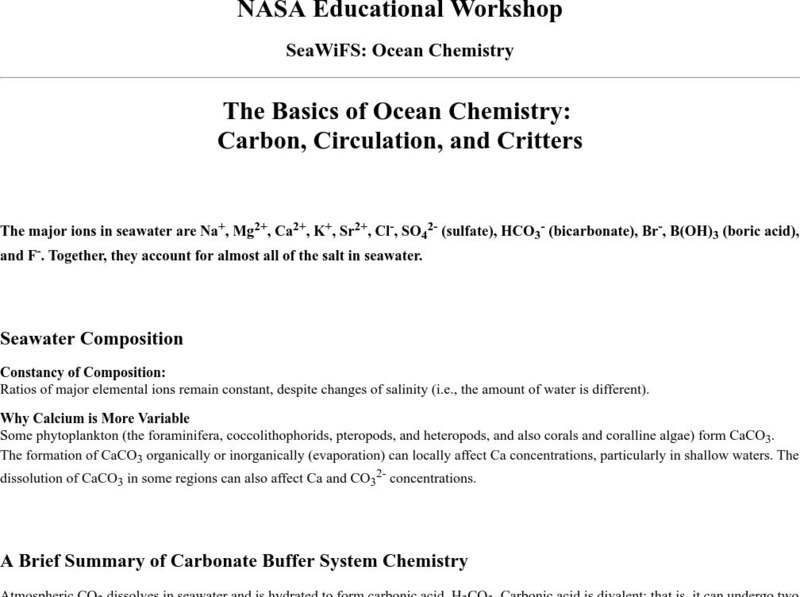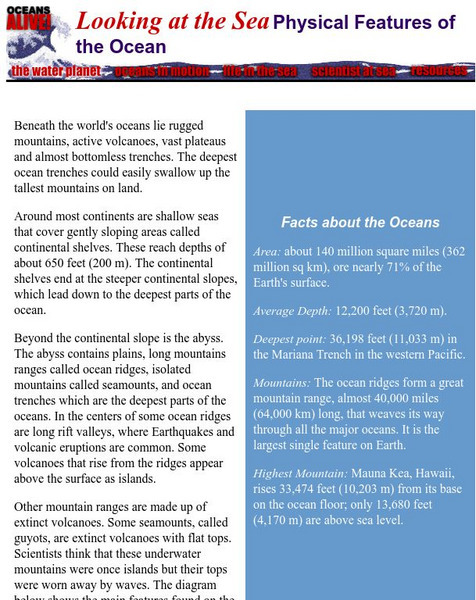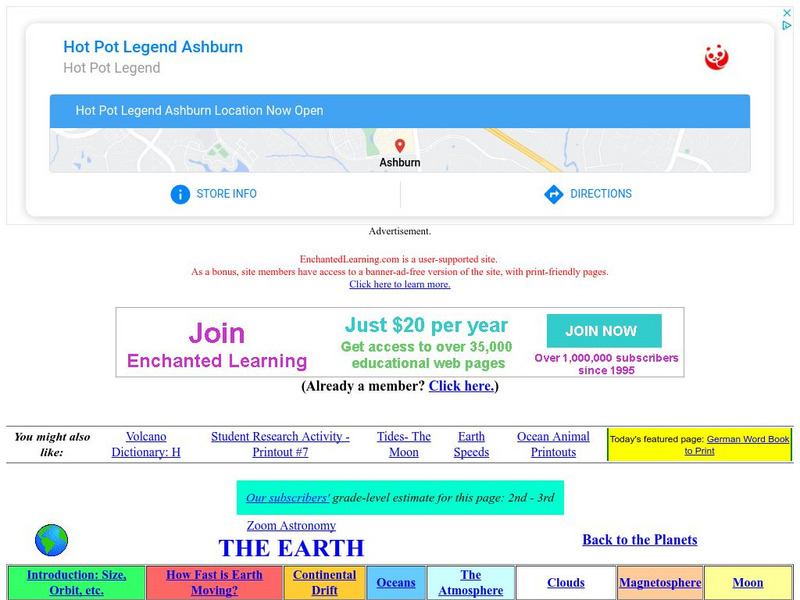Curated OER
Marine Fisheries Management
Almost 200 slides make this a vast collection! It is a quirky collection, titled "Marine Fisheries Management," but having little to do with that occupation. What you will find are two-toned blue backgrounds with no pictures, but a few...
Curated OER
The Open Ocean, What is it and How Does it Change?
Students investigate the ocean environment. For this ocean lesson, students discover the physical properties of the ocean. Over two days, students work in small groups investigating ocean maps and creating water currents.
Curated OER
Exploring The Depths!
Fifth graders make a model of the ocean floor. In this ocean characteristics lesson, 5th graders complete a KWL chart about the ocean floor, use the Ocean Depth Data Sheet to create a graph, and create a 3-D model of the ocean floor.
SEDL
Oceans [Pdf]
This large PDF file integrates math, science, and language into several lessons about characteristics of the oceans. Topics include ocean currents, tides, density, marine life, and pollution.
Smithsonian Institution
National Museum of Natural History: Ocean Planet
Detailed website that was a companion to a 1995 traveling exhibit of the Smithsonian. Links to lesson plans and other educational materials are at the bottom of the page. Enter the exhibition to explore the world of the ocean.
NOAA
Noaa: Stressed Out! [Pdf]
In this lesson, students investigate factors that affect the health of the oceans. These include overfishing, the destruction of habitats, the invasion of foreign species, the impact of pollution, and the increasing acidification. An...
The Franklin Institute
Treasures@sea: Exploring the Ocean Through Literature
This extensive resource consists of learning activities that integrate language arts with oceanography. Each activity is based on one of seven books about the ocean and are written to be adaptable. Includes writing activities, games and...
University of California
Uc Davis Geo Wiki: Chemical Budgets of Oceanic Elements
To the extent that the composition of the ocean remains constant, the rate at which any one element is introduced into seawater must equal the rate of its removal. A listing of the various routes of addition and removal, together with...
Simon Fraser University
Chem1 Virtual Textbook: Chemical Budgets of Oceanic Elements
As part of the General Chemistry Virtual Textbook, this site examines a variety of topics related to the elements of the oceans. Topics covered include Phosphorus, Carbon, Bicarbonate, Calcite, and more.
Missouri Botanical Garden
Missouri Botanical Garden: Temperate Oceans Light Zones
Discover the three zones in the ocean which are determined by the amount of light received from the sun. Pictures illustrate the three zones and there is a listing of the animals that live in each zone.
PBS
Pbs: Journey Into the Abyss
Go on an interactive journey to the Pacific Northwest Coastline. You will be able to view a black smoker chimney along with the scientist. GREAT SITE!
NOAA
Noaa: Ne Mo: Hydrothermal Vents
Clearly describes hot springs on the ocean floor called hydrothermal vents. Details characteristics of the vents and how they work.
US Navy
Office of Naval Reasearch: Ocean Floor
A comprehensive site that provides information on the characteristics of the ocean floor, continental margin and rise, deep ocean basin, and the mid-ocean ridge. A quick quiz follows at the end of this site.
Writing Fix
Writing Fix: Action Packed Ocean Sentences
In this lesson plan, Andrew Clement's awesome picture book, Big Al is used as a mentor text. Students will record their favorite verbs from the mentor text, rank them according to their favorite, and share them. Students will also use...
CK-12 Foundation
Ck 12: Earth Science: Seawater Chemistry
[Free Registration/Login may be required to access all resource tools.] Describes dissolved ions in seawater and their source.
CK-12 Foundation
Ck 12: Earth Science: Continental Margins
[Free Registration/Login may be required to access all resource tools.] Discusses the differences between active and passive continental margins.
CK-12 Foundation
Ck 12: Earth Science: Elevation on the Earth
[Free Registration/Login may be required to access all resource tools.] Using latitude and longitude to find a location.
NASA
Nasa: The Basics of Ocean Chemistry: Carbon, Circulation, and Critters
An explanation of ocean chemistry, supported by illustrations, for example, of the global carbon cycle in the 1980s and the annual carbon dioxide flux. The concentration of nutrients in the ocean is discussed for its impact on marine...
Museum of Science
Oceans Alive! Physical Features of the Ocean
Oceans site explores the physical features that lie deep below the surface of our world's oceans.
Enchanted Learning
Enchanted Learning: Zoom School: Oceans
Find out why the oceans are blue and what causes waves by clicking here. There is a table of information about the four oceans as well as interesting facts on waves, salinity, and tides.
Science Struck
Science Struck: Facts About the Aphotic (Midnight) Zone of the Ocean
The aphotic zone of the ocean receives less than one percent of sunlight penetration. It extends from between 200 to 1,000 m, or 660 to 3,300 ft, down to the seafloor. Learn about the characteristics of this zone and the adaptations the...
Science Struck
Science Struck: The Differences Between Benthic and Pelagic Zones
Learn the characteristics of these two oceanic zones and of the plants and animals that live in them.
BiologyWise
Biology Wise: Marine Biology Facts
Discusses the unique characteristics of the oceans and the many organisms that live in a marine ecosystem.
American Museum of Natural History
American Museum of Natural History: Sea Snow O Logy Card
OLogy cards are like virtual baseball cards about all kinds of science topics. This one is about sea snow and it contains information about what it is and where it is found.





![Oceans [Pdf] Activity Oceans [Pdf] Activity](https://d15y2dacu3jp90.cloudfront.net/images/attachment_defaults/resource/large/FPO-knovation.png)


